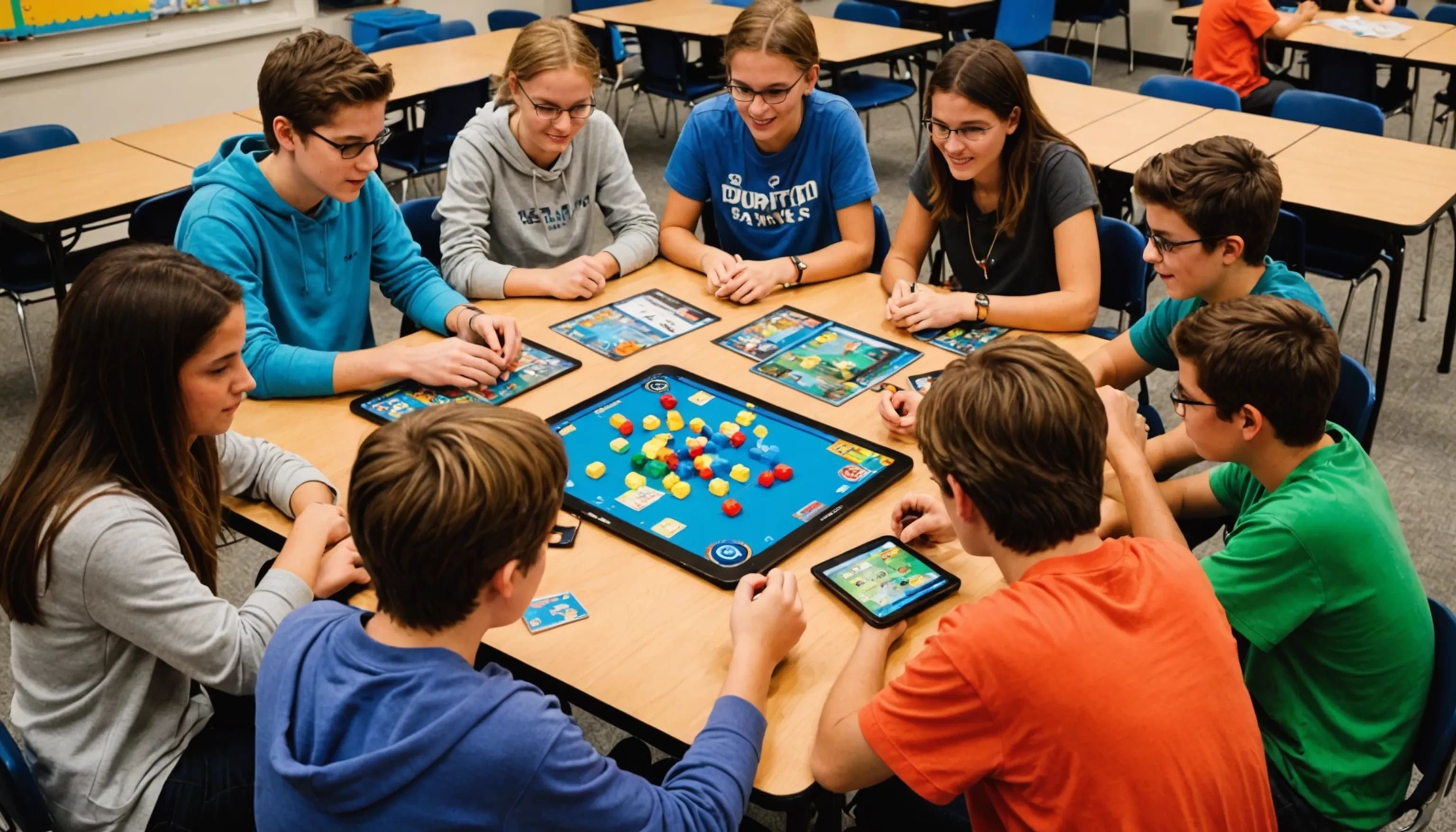Games for Teaching Math Problem-Solving Skills
 HvWHenry van Wagenberg
HvWHenry van Wagenberg
Effective Games for Teaching Math Problem-Solving Skills
Effective games for teaching math problem-solving skills can transform the learning experience for teenagers. These games engage students and make complex concepts more accessible. From board games to online platforms, a variety of options are available.
Games such as Math Bingo or 24 Game not only foster critical thinking but also encourage friendly competition. Moreover, interactive math apps like Prodigy or Kahoot! provide instant feedback and adapt to individual learning paces. By incorporating these games into math lessons, educators can enhance students' problem-solving abilities while keeping them motivated.
Why Use Games for Math Problem-Solving?
Using games for teaching math problem-solving skills offers numerous benefits that can enhance the learning experience for teenagers. First and foremost, games create an engaging environment that motivates students to participate actively. When students are having fun, they’re more likely to stay focused and retain information.
Moreover, games encourage critical thinking and strategic planning. They require players to analyze problems, make decisions, and adapt their strategies based on outcomes. This mirrors real-world scenarios where math skills are essential, thus helping students develop their problem-solving abilities in a practical context.
Additionally, games promote collaboration and communication among peers. Many math games can be played in groups, fostering teamwork and social interaction. This collaborative atmosphere allows students to learn from one another, share different approaches to problem-solving, and build valuable interpersonal skills.
Furthermore, using games in math education caters to various learning styles. Visual learners benefit from colorful game designs, while kinesthetic learners engage through hands-on activities. This diversity ensures that all students have the opportunity to grasp mathematical concepts effectively.
Finally, games provide immediate feedback, which is crucial for learning. Students can see the results of their strategies and adjust their approaches accordingly. This instant reinforcement helps solidify their understanding of mathematical concepts and enhances their overall problem-solving skills.
Types of Games for Math Skills
There are various types of games designed to enhance math skills among teenagers. Each type offers unique benefits and caters to different learning preferences.
Board Games are classic tools that combine fun with education. Games like Monopoly teach financial literacy, while Sum Swamp focuses on addition and subtraction.
Card Games such as Math War promote quick thinking and reinforce basic arithmetic skills. Players compete to solve problems faster than their opponents, making learning competitive and engaging.
Online Math Games provide a digital twist. Websites like Kahoot! and Prodigy offer interactive experiences that adapt to individual learning paces, ensuring personalized learning.
Interactive Apps on smartphones and tablets make math practice accessible anywhere. Apps like DragonBox gamify algebra concepts, making them easier to understand.
 enhance math skills for teenagers" style="max-height: 15rem; width: 100%; border-radius: 0.375rem; object-fit: cover;" />
enhance math skills for teenagers" style="max-height: 15rem; width: 100%; border-radius: 0.375rem; object-fit: cover;" />
Board Games that Enhance Math Skills
Board games are an excellent way to enhance math skills in teenagers while providing a fun and interactive learning environment. These games not only engage students but also reinforce essential mathematical concepts in an enjoyable manner.
One popular board game is Monopoly, which teaches financial literacy and basic arithmetic through buying, selling, and trading properties. Players must calculate rents, manage budgets, and make strategic decisions, reinforcing their understanding of addition, subtraction, and multiplication.
Another effective game is Sum Swamp, designed specifically for younger audiences but can be adapted for older players. It promotes addition and subtraction while navigating through a swamp filled with challenges, making math practice exciting.
Prime Climb is another fantastic option, where players use basic arithmetic operations to advance on a colorful, spiral board. This game introduces concepts like prime numbers and factors, helping students grasp more complex mathematical ideas.
Blokus is a strategic game that enhances spatial reasoning and geometry skills. Players must place their pieces on the board while following specific rules, encouraging critical thinking and planning.
By incorporating these board games into learning, parents and educators can provide students with an engaging way to practice math skills, fostering both confidence and competence in mathematics.
Online Math Games for Teenagers
Online math games have become increasingly popular for enhancing math skills among teenagers, offering an interactive and engaging way to learn. These games provide instant feedback and adapt to individual learning paces, making them ideal for varied skill levels.
One notable platform is Prodigy Math, which combines role-playing elements with math challenges. Students progress through a fantasy world by solving math problems tailored to their grade level. This game not only makes learning fun but also aligns with curriculum standards, ensuring that students practice relevant skills.
Another excellent resource is Kahoot!, where teachers can create customized quizzes that students compete in real-time. This game encourages healthy competition and collaboration while focusing on specific math concepts, from basic arithmetic to advanced algebra.
Math Playground offers a variety of games covering multiple math topics, including logic puzzles and problem-solving challenges. Its diverse range of activities keeps students engaged and allows for practice in a fun environment.
Additionally, Coolmath Games provides a plethora of math-related games that focus on strategy and critical thinking. These games encourage students to apply their math knowledge in creative ways, further solidifying their understanding.
Incorporating online math games into the learning process not only enhances problem-solving skills but also keeps students motivated and excited about mathematics.
Interactive Math Apps for Problem Solving
Interactive math apps are an effective way to enhance problem-solving skills among teenagers, providing a convenient and engaging platform for learning. These apps cater to various learning styles and offer personalized experiences, making math practice both fun and effective.
Here are some standout interactive math apps:
- DragonBox: This app gamifies algebra concepts, allowing students to explore mathematical principles through intuitive gameplay. It gradually introduces complex ideas in a way that feels natural and enjoyable.
- Photomath: This innovative app allows students to take pictures of handwritten or printed math problems and receive step-by-step solutions. It not only helps with homework but also teaches problem-solving strategies.
- Khan Academy: Offering a comprehensive range of math topics, this app provides instructional videos, practice exercises, and personalized learning dashboards. Students can learn at their own pace and revisit concepts as needed.
- Mathway: This app serves as a math problem solver, offering solutions to a wide array of mathematical problems. It helps students understand the process behind each solution, enhancing their problem-solving skills.
- Prodigy Math: Combining game mechanics with curriculum-aligned math challenges, this app engages students in an immersive fantasy world where they solve problems to progress.
By incorporating these interactive math apps into their study routines, teenagers can strengthen their problem-solving abilities while enjoying the learning process.

Tips for Incorporating Games into Learning
Incorporating games into learning can significantly enhance math problem-solving skills for teenagers. Here are some effective tips:
- Set Clear Objectives: Define what math concepts you want to reinforce through games.
- Mix It Up: Use a variety of games, from board games to online platforms, to keep students engaged.
- Monitor Progress: Track students’ performance and adjust game choices based on their needs.
- Encourage Collaboration: Promote teamwork by organizing group games that require communication and strategy.
- Limit Screen Time: Balance digital games with traditional methods to ensure a well-rounded approach.
Setting Goals for Game-Based Learning
Setting goals for game-based learning is essential to ensure that teenagers effectively enhance their math problem-solving skills. Clear objectives provide direction and help measure success. Here are some strategies for establishing effective goals:
1. Define Learning Outcomes: Start by identifying the specific math skills you want students to improve. This could include mastering algebraic concepts, enhancing mental math abilities, or developing logical reasoning.
2. Align Games with Curriculum: Choose games that complement the curriculum and meet educational standards. Ensure that the games selected directly address the learning outcomes you've defined.
3. Set Measurable Goals: Establish clear, measurable goals, such as “Increase problem-solving speed by 20%” or “Achieve an accuracy rate of 85% on math challenges.” This allows for tracking progress over time.
4. Encourage Self-Assessment: Teach students to reflect on their performance after playing games. Encourage them to identify areas of strength and those needing improvement.
5. Foster a Growth Mindset: Emphasize the importance of persistence and learning from mistakes. Remind students that challenges in games are opportunities to grow their skills.
6. Celebrate Achievements: Recognize and celebrate milestones reached during game-based learning. This boosts motivation and encourages continued engagement.
By setting clear goals, educators can create a structured environment where game-based learning effectively enhances math skills while keeping students motivated.
Creating a Balanced Game Schedule
Creating a balanced game schedule is crucial for maximizing the benefits of game-based learning in mathematics. A well-structured schedule ensures that students can engage with games while also meeting their educational needs. Here are some strategies for developing an effective game schedule:
1. Assess Learning Objectives: Begin by identifying the specific math skills you want to address through game-based learning. This will help you choose appropriate games and allocate time effectively.
2. Allocate Time Wisely: Determine how much time will be dedicated to game-based learning each week. Balance this with traditional instruction to ensure comprehensive coverage of the curriculum. Consider allocating specific days for game activities.
3. Mix Game Types: Include a variety of games to cater to different learning styles and preferences. Incorporate board games, online games, and interactive apps to keep students engaged and motivated.
4. Monitor Engagement: Regularly assess student engagement and interest in the games being played. Be open to adjusting the schedule based on student feedback and participation levels.
5. Integrate Reflection Time: After game sessions, set aside time for students to reflect on what they learned. Encourage discussions about strategies used and concepts mastered.
6. Ensure Flexibility: Be prepared to adapt the game schedule as needed. Life events, school commitments, or changes in learning goals may require adjustments to the plan.
By creating a balanced game schedule, educators can foster a dynamic learning environment where students develop their math problem-solving skills while enjoying the process.
Monitoring Progress and Engagement
Monitoring progress and engagement is essential for maximizing the effectiveness of game-based learning in enhancing math problem-solving skills among teenagers. By tracking both academic performance and student interest, educators can make informed decisions to improve the learning experience. Here are some strategies for effective monitoring:
1. Set Baseline Assessments: Before introducing games, establish a baseline by assessing students’ current math skills. This provides a reference point to measure progress over time.
2. Use Game Analytics: Many online math games offer built-in analytics that track student performance. Monitor metrics such as completion rates, accuracy, and time spent on tasks. This data can highlight areas of strength and those needing improvement.
3. Conduct Regular Check-Ins: Schedule periodic one-on-one or group discussions with students to gauge their engagement levels. Ask open-ended questions about their experiences with the games and any challenges they encounter.
4. Encourage Self-Reflection: Have students maintain a learning journal to reflect on their progress and engagement with game-based activities. This encourages them to think critically about their learning journey.
5. Adjust Instruction as Needed: Use the data gathered to modify game choices or instructional strategies. If certain games are particularly effective or engaging, consider incorporating them more frequently.
6. Celebrate Achievements: Recognize and celebrate improvements in skills and engagement. This motivates students and reinforces their commitment to learning through games.
By actively monitoring progress and engagement, educators can create a responsive learning environment that maximizes the benefits of game-based learning in mathematics.
